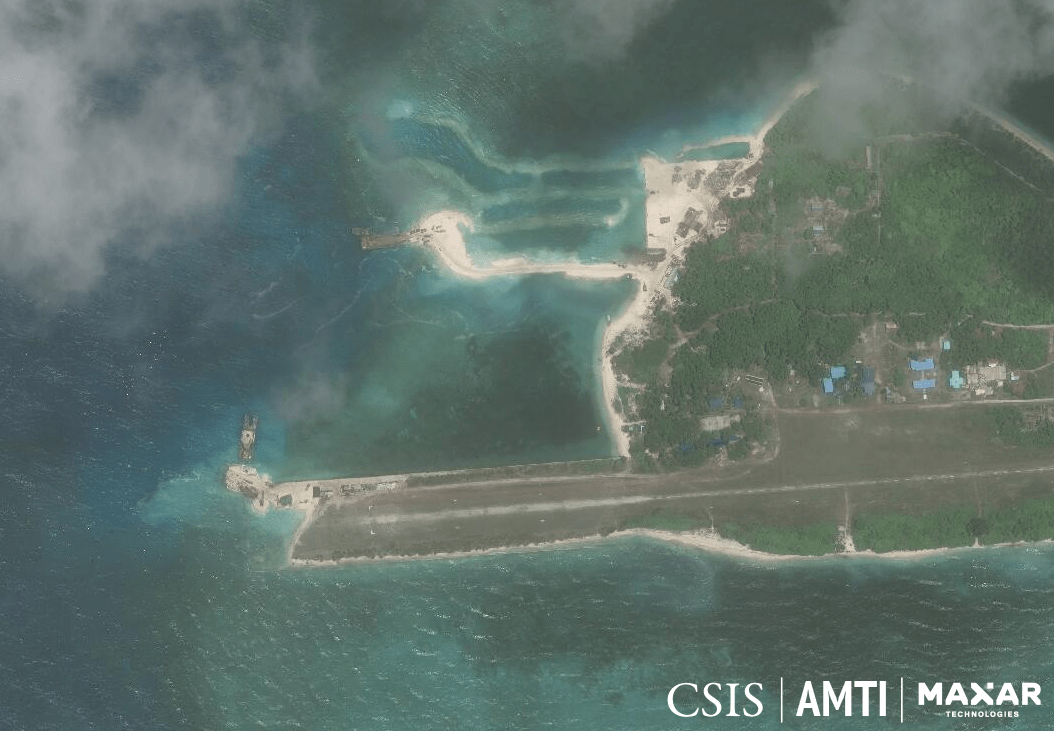SUMMARY
This is AI generated summarization, which may have errors. For context, always refer to the full article.

MANILA, Philippines – The country’s defense chief denied a report that the presence of Chinese vessels around Pag-asa (Thitu) Island hampered efforts to upgrade facilities on the Philippines’ main outpost in the West Philippine Sea.
“I do not know where AMTI’s allegation came from. It’s totally false,” said Defense Secretary Delfin Lorenzana on Tuesday, March 10, commenting on a report by the Asia Maritime Transparency Initiative (AMTI) of the Washington-based Center for Strategic and International Studies (CSIS).
“Although there are always Chinese ships in the vicinity of Pag-asa…they have never in any way interfered with the rehabilitation of the island,” Lorenzana added.
On Friday, March 6 (Philippines time), AMTI-CSIS published a report detailing the presence and movement of Chinese vessels around Pag-asa over a period of 16 months. Although appearing to be fishing boats, the vessels were not doing actual fishing, the think-tank observed based on an analysis of satellite images. Instead, the flotilla appeared to function as militias, exercising China’s presence around the Philippine controlled island.
Noting how the appearance of the vessels coincided with the Philippine government’s staggered efforts to refurbish the island’s facilities, AMTI said “the Philippines has slowly made progress on its upgrade work at Thitu after repeated delays. Officials in Manila have consistently blamed the delays on bad weather, but it seems likely that the constant Chinese militia presence has played a role.”
The government announced plans as early as April 2017 to build a beaching ramp on the island to service the delivery of materials and equipment to repair and pave its existing airstrip.
Satellite photos from AMTI taken in mid-February showed the work on Pag-asa was underway but not finished. Aside from the beaching ramp taking shape and improvements on the runway, the images also showed the construction of what appears to be a harbor.
Lorenzana said other factors – not harassment from the Chinese vessels – caused delays in the construction.
“There was a big problem at the initial stage of the Pag-asa rehabilitation project. The seabed where the beaching ramp was to be built was found to be so hard, the contractor had to bring in the appropriate drilling equipment. When work finally started, it was slow because of this problem. Second, all equipment and materials are shipped from Puerto Princesa. The seas in the Spratlys are usually rough that the contractor’s barges can only transport materials within a small window of time from January to April or May. After that it depends on the weather,” Lorenzana explained.
Unless the beaching ramp is finished, no major construction work can proceed on the island because all supplies – cement, steel bars, gravel, sand – and heavy equipment will have to be brought in through it.
A fisherman’s shelter on the island appeared to be “halfway done,” based on a photo from early February, Lorenzana added.
Chinese vessels were first detected in the vicinity of Pag-asa in December 2018. The Philippine government protested their presence in April 2019. Although the number of vessels varied throughout the succeeding months, AMTI said their presence has been consistent, with at least 18 vessels throughout the last 16 months.
Experts have noted the “swarm” as a “gray zone tactic” by China to assert its claim of ownership over the West Philippine Sea, despite an international arbitral ruling that debunks its claim and affirms the Philippines’ sovereign rights in the area.
The Department of National Defense itself, headed by Lorenzana, reported to Congress in September 2019 that the Chinese fishing vessels around Pag-asa were possibly militias, or a paramilitary force.
On March 2, the Philippine military in Palawan reported that 136 individual Chinese boats were spotted around Pag-asa in January and February. The following day, National Security Adviser Hermogenes Esperon Jr told reporters that the vessels were likely to remain in the area, especially because China has a harbor in Zamora (Subi) Reef, just 14 nautical miles away from the island.
Lorenzana echoed this view on Tuesday.
Zamora Reef is one of 7 formerly submerged features that China reclaimed and turned into outposts in the West Philippine Sea. Zamora Reef has been transformed into a full-fledged military base with a 3-km runway worthy of fighter jets, and a large harbor for vessels.
Pag-asa Island is the largest of 9 Philippine-controlled features in the West Philippine Sea. It is home to some 250 Filipinos, many of them civilians. – Rappler.com
Add a comment
How does this make you feel?
There are no comments yet. Add your comment to start the conversation.